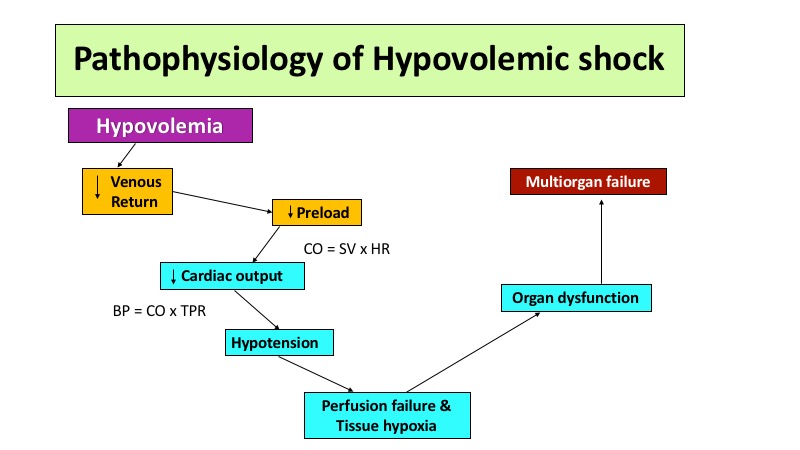
The term “shock” originates from the term “choc” which dates back to the 18th century, when French army surgeon Henri Francois Le Dran coined the term to describe the loss of vital functions leading to death, which he observed often in the soldiers on which he operated. 1 About a century later, John Collins Warren reported shock as a “momentary pause in the act of death.” 1 Although our understanding of the physiology related to shock is more informed today, a diagnosis of shock still carries the same urgency that it did when Henri and John Collins practiced. While prompt treatment of shock is crucial to lowering morbidity and mortality in all types of shock, Meyer et al. showed every minute before volume resuscitation in hypovolemic shock increased the mortality risk by 5%.2 The following hemorrhagic hypovolemic cases illustrate the positive impact that early, rapid volume resuscitation can have on patient outcomes.
Case #1: A 39-Year old Male with Haematemesis
A 39-year old male presented to the emergency department with haematemesis, jaundice and hypotension with a blood pressure of 59/22mmHg. The patient was conscious with a medical history of esophageal varices secondary to alcoholic hepatitis, previous GI bleed with banding and thrombocytopenia. Haematemesis was preceded by nausea the previous day and EMS reported 1-2L of blood lost via emesis. Upon arrival, in addition to the severe hypotension, he was tachycardic with an oxygen saturation of 95% with 3L of oxygen through a nasal cannula. His arterial blood sample had a pH of 6.60, pCO2 of 103mmHg, pO2 of 63mmHg, bicarbonate level of 10.2mEq/L, and base excess -28mEq/L.
Due to the dangerous state of hypovolemic shock, two large bore IV’s were placed and 3L of normal saline was given over the next few minutes (2L with the LifeFlow device and 1L with a pressure bag). His vitals immediately improved substantially to a blood pressure of 118/60 and pulse oximetry value of 100%. The patient’s CBC lab results came back post volume resuscitation with values of hemoglobin at 8.6g/dL and platelets at 24X10^9/L. The thrombocytopenia and anemia were treated with 10 units of red blood cells, 1 unit of platelets, and three units of fresh frozen plasma in the ER without further incidence of hypotension. The patient was transferred to the ICU and a few days later the patient underwent surgery to insert a transjugular intrahepatic portosystemic shunt to reduce portal hypertension. The patient recovered back to baseline and was discharged 5 days post-operatively.
Case #2: A 60-Year old Male with Lower GI Bleed
A 60-year old male presented to the emergency department via EMS after complaining of rectal bleeding. His medical history included COPD, hypertension, diabetes and cocaine use. The patient arrived in the ED with a 17-gauge peripheral IV, blood pressure of 96/40mmHg, respiratory rate of 22, oxygen saturation of 100% on room air, and a hematocrit of 15g/dL. While awaiting packed red blood cells to arrive from the blood bank, 1L of normal saline was administered with the LifeFlow rapid infusion device. While still in hemorrhagic, hypovolemic shock, this improved his mean arterial blood pressure to 80 from 70mmHg. After the blood was transfused, the blood pressure was 86/51, and the patient was transferred to the OR to stop the rectal bleed. He recovered and was discharged with home health support 3 days post-operatively.

Hypovolemic shock is one of the most acute forms of shock, necessitating swift recognition and treatment.3 Lost intravascular volume leads to decreased preload and ultimately reduced oxygen delivery. 3 Treatment recommendations include swift fluid resuscitation to replace intravascular volume, endotracheal intubation if hypoxic, and quick bleeding control if possible. 2-4 These two cases exemplify patients we often see where the progression to refractory or irreversible shock is imminent but not inevitable. With swift diagnosis and intervention we can arrest the downward spiral and stabilize the patient.
Interested in learning more about LifeFlow? Contact us.
- Frost P, Wise M. Recognition and management of the patient with shock. Acute Med. 2006;5(2):43-47.
- Meyer DE, Vincent LE, Fox EE, et al. Every minute counts: Time to delivery of initial massive transfusion cooler and its impact on mortality. J Trauma Acute Care Surg. 2017;83(1):19-24. doi:10.1097/TA.0000000000001531.
- Standl T, Annecke T, Cascorbi I, Heller AR, Sabashnikov A, Teske W. The Nomenclature, Definition and Distinction of Types of Shock. Dtsch Arztebl Int. 2018 Nov 9;115(45):757-768. doi: 10.3238/arztebl.2018.0757. PMID: 30573009; PMCID: PMC6323133.
- Moranville MP, Mieure KD, Santayana EM. Evaluation and Management of Shock States: Hypovolemic, Distributive, and Cardiogenic Shock. Journal of Pharmacy Practice. 2011;24(1):44-60. doi:10.1177/0897190010388150.

